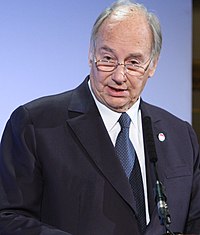Aga Khan
This articleneeds additional citations forverification.(November 2018) |
| His Royal Highness Prince Aga Khan ofthe Imamate of theNizariIsmāʿīliShias | |
|---|---|
| Persian:آقاخان Arabic:آغا خان | |
| Incumbent | |
 The current Aga Khan, pictured in 2014 | |
| Shah Karim al-Husseini since 11 July 1957 | |
| Details | |
| Style | His Highness |
| First monarch | Hasan Ali Shah |
| Formation | 1817 |
| Part ofa seriesonIslam Isma'ilism |
|---|
 |
|
|
Aga Khan(Persian:آقاخان,Arabic:آغا خان;also transliterated asAqa KhanandAgha Khan)[1]is a title held by theImāmof theNizariIsmāʿīliShias.Since 1957, the holder of the title has been the 49th Imām, PrinceShahKarim al-Husseini,Aga Khan IV(born 1936). Aga Khan claims to be a direct descendant ofMuhammad,the last prophet according to the religion ofIslam.
Title[edit]
The title is made up of the titles "agha"and"khan".The Turkish" agha "is" aqa "(Āqā) inPersian.The word "agha"comes from theOld TurkicandMongolian"aqa", meaning "elder men",[2][3]and means something like "master" or "lord." "Khan"means king or ruler in Turkish and Mongolian languages.[4]
According toFarhad Daftary,[5]a scholar of the Isma'ili movement,Aga Khan[6][7]is an honorific title bestowed onHasan Ali Shah(1800–1881), the 46th Imām ofNizari Ismai'lis(1817–1881), bythe Iranian kingFath-Ali Shah Qajar.[8]However, Daftary apparently contradicts what the Aga Khan III noted in a famous legal proceeding in India: thatAga Khanis not a title but instead analiasthat was given to the Aga Khan I when he was a young man.[7][9]
History[edit]
During the latter stages of theFirst Anglo-Afghan War(1841–1842),Hasan Ali Shahand his cavalry officers provided assistance toGeneral NottinKandahar Provinceand toGeneral Englandin his advance fromSindhto join Nott.[citation needed]For these and for other diligent efforts made by him in the service of the Empire, theBritish Rajrecognised him as a "Prince". This title was less extraordinary in that time and place than it seems today, because the British while consolidating their hold on India, had been handing out similar titles liberally to any large landowner or tribal chieftain with local influence who made himself useful to them.
The Aga Khan was exceptional in that, while it was the local tribal influence that had enabled him to serve the British and gain their favour, his claim to nobility was based upon his claim to leadership of an entire sect of Islam. Imperial Britain saw great possibilities in having under their control and patronage the head of a majorShiasect; it could even be used at some later stage to counterbalance the influence of theOttoman Caliph,the head of Islam as recognized by theSunnisects. The Aga Khan was the only religious or community leader inBritish Indiagranted a personalgun salute.[10]
WhenHasan Ali Shah,the first Aga Khan, came to Sindh (which is now inPakistan) fromAfghanistan,he and his army were welcomed byMir Nasir Khan NooriofBaluchistan.[citation needed]In 1866, theAga Khanwon a court victory in theHigh Court of Bombayin what popularly became known as theAga Khan Case,securing his recognition by theBritish governmentas the head of theKhojacommunity. The Aga Khan is also thePirwithin theNizariIsmailicommunity.
The Bombay High Court decision of 1866recognized Aga Khan I as the hereditaryImāmof Isma'ilis.[11]
In 1887, theSecretary of State for India,acting through theViceroy of India,formally recognized the titleAga Khan.[12]
List of Aga Khans[edit]
Four Ismāʿīli imāms have held this title:
- Aga Khan I– Hasan Ali Shah Mahallati (1804–1881), 46th Imam of Nizari Ismailis (1817–1881)
- Aga Khan II– Shah Ali Shah (about 1830–1885), 47th Imam of Nizari Ismailis (12 April 1881 – August 1885)
- Aga Khan III– Sir Sultan Mohammed Shah (1877–1957), 48th Imam of Nizari Ismailis (17 August 1885 – 11 July 1957)
- Aga Khan IV– Prince Shah Karim Al Husseini (born 1936), 49th Imam of Nizari Ismailis (11 July 1957 – present)
See also[edit]
- Imamate in Nizari doctrine
- Imamate in Shia doctrine
- List of Ismaili imams
- Nizari Ismaili state
- Noorani family
References[edit]
- ^Daftary, Farhad(2007).The Ismāʻı̄lı̄s: their history and doctrines(2nd ed.).Cambridge University Press.ISBN978-0-511-35561-5.
- ^"the definition of aga".Dictionary.Archivedfrom the original on 7 July 2016.Retrieved17 June2016.
- ^"imla".nisanyansozluk.Archivedfrom the original on 22 July 2015.Retrieved17 June2016.
- ^Fairbank, John King (1978).The Cambridge History of China.Cambridge University Press. p. 367.
- ^"The Institute of Ismaili Studies".Archived fromthe originalon 12 May 2013.Retrieved2 April2013.
- ^Daftary, Farhad(2011),"A Modern History of the Ismailis: Continuity and Change in a Muslim Community", I.B. Tauris & Co., 416 p., pp. 1–2Archived31 December 2018 at theWayback MachineISBN978-1845117177
- ^ab(...) H.H. the Aga Khan 'who is known amongst his followers by the following names: "Hazarat Mowlana Dhani Salamat Datar, Pir Salamat, Sarkar Saheb, Huzur Pur Nur, Dhani Salamat, Hazar Imam, Dhani Pir, Aga Khan."'
- ^Daftary, Farhad(2004).Ismaili Literature: A Bibliography Of Sources And Studies.Institute of Ismaili Studies.ISBN978-1-850-43439-9.
- ^Russell, Justice."Haji Bibi vs H.H. Sir Sultan Mahomed Shah, 1 September 1908".indiankanoon.org.Indian Kanoon.Archivedfrom the original on 14 July 2018.Retrieved14 November2018.
- ^"Table of Personal Salutes, 11 Gun Salutes".The India Office and Burma Office List for 1945:43. 1945.
Table of Personal Salutes, Salutes of 11 Guns
- ^Cole, Juan Ricardo (1989).Roots of north indian shīʻism in Iran and Iraq: religion and state in Awadh, 1722-1859.Oxford University Press.ISBN0-19-562326-6.OCLC25380111.
- ^Vankwani, Dr Ramesh Kumar (14 June 2017)."The Aga Khan's legacy".The News International.Retrieved2 June2022.
Further reading[edit]
- "Les Agas Khans", Yann Kerlau, Perrin 2004
